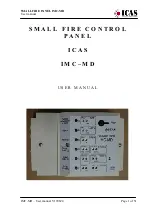
13
the battery. This will cause undercharging of the battery.
See section 4.2-4.
g. Check the condition of the battery. Determine if the battery
voltage declines at night with no load. If unable to maintain
its voltage, the battery may be failing.
h. If all the ProStar LED’s are flashing in sequence, see item
number 4 below.
i. Check that the controller is operating at the correct system
voltage (12 or 24 vdc), and that the battery has enough volt-
age (over 8 volts) to operate the controller. If there is any
question, reset the controller by removing the
B
wire from the terminal and reconnecting it to the controller.
j. If the battery, PV array and wire connections seem to be sat-
isfactory, and if the ProStar LED indications are not normal
(refer to section 3.1 “LED Indicators”), then the ProStar may
be defective.
N
OTE
:
The controller’s microprocessor should be reset
(restarted) if any of the following conditions seem
to exist:
• The microprocessor latches (locks-up)
• The controller seems to be operating at the wrong
system voltage (12 or 24 volts)
• The battery voltage fell below 8 volts and the
controller cannot automatically restart
• A load short-circuit caused the controller to shutdown
To reset the processor, simply remove the
B
wire and reconnect it to the controller. With the LCD
meter option, just press the red
DISCONNECT
but-
ton twice. The controller will sequence through it’s
entire start-up routine (See section 4.2).
2. B
ATTERY
V
OLTAGE
I
S
T
OO
H
IGH
a. Check the operating conditions to confirm that the voltage
is higher than specifications. Consider the temperature
compensation and automatic equalizations. For example,
a 12 volt flooded battery at 0°C in equalization will be
regulated at about 15.4 volts.
b. Check that the proper
BATTERY TYPE
has been selected.
c. Check that all wire connections in the system are correct and
tight.


































